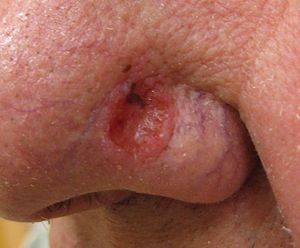Skin Cancer
Skin cancer is a medical condition involving the uncontrolled growth of skin cells. It is the most commonly diagnosed form of cancer in humans, with three main types: basal-cell carcinoma (BCC), squamous-cell carcinoma (SCC), and melanoma. Each type has distinct characteristics, risk factors, and treatment protocols.
Types of Skin Cancer
Basal-Cell Carcinoma (BCC)
BCC is the most common and least aggressive form of skin cancer. It usually presents as a raised, smooth, pearly bump on sun-exposed areas of the skin, such as the head, neck, and torso. Sometimes small blood vessels (telangiectasia) can be seen within the tumour. It rarely metastasizes and is often curable with surgery or radiation.

Squamous-Cell Carcinoma (SCC)
SCC is less common than BCC but more likely to spread. It typically appears as a red, scaly, thickened patch on sun-exposed skin. Ulceration and bleeding may occur. It is more dangerous than BCC but less aggressive than melanoma.

Melanoma
Melanoma is the most aggressive form of skin cancer. It often presents as a mole that changes in size, shape, or colour, and may have irregular edges. It can metastasize rapidly and is responsible for the majority of skin cancer-related deaths.

Causes and Risk Factors
The primary cause of skin cancer is ultraviolet (UV) radiation from the sun or tanning beds. Other risk factors include having light skin, poor immune function, chronic non-healing wounds, and exposure to ionising radiation. Genetic predispositions, such as congenital melanocytic nevi syndrome, also increase risk.
Pathophysiology
UV radiation causes DNA damage in skin cells, leading to mutations that can result in cancer. BCC and SCC often carry a UV-signature mutation caused by UVB radiation. Melanoma, however, is predominantly caused by UVA radiation through indirect DNA damage involving free radicals.

Signs and Symptoms
Common signs of skin cancer include changes in the skin that do not heal, ulceration, discoloured skin, and changes in existing moles. Specific symptoms for each type include:
- BCC: Raised, smooth, pearly bump with possible blood vessels.
- SCC: Red, scaling, thickened patch or firm nodule.
- Melanoma: Moles that change in size, shape, or colour, or new moles appearing in adulthood.
Diagnosis
Diagnosis is primarily made through biopsy and histopathological examination. Non-invasive methods like dermatoscopy, sonography, and confocal microscopy can aid in diagnosis. Computer-assisted diagnosis devices are also being developed for enhanced detection.
Prevention
Preventive measures include decreasing UV exposure, using sunscreen, and avoiding tanning beds. Wearing protective clothing, sunglasses, and hats also helps. The U.S. Preventive Services Task Force recommends advising people aged 9 to 25 to avoid UV light.
Treatment
Treatment varies based on the type of skin cancer, location, patient age, and recurrence status. Options include surgery, radiation therapy, and topical medications like fluorouracil. Mohs surgery is often used for its high cure rate and minimal tissue removal. For metastatic melanoma, biologic immunotherapy agents and targeted therapies are available.
Prognosis
The mortality rate for BCC and SCC is low, whereas melanoma has a higher mortality rate. Early detection and treatment significantly improve survival rates. Australia and New Zealand have the highest incidence rates, with melanoma being the most common cancer in people aged 15 to 44.

Self-assessment MCQs (single best answer)
Which of the following is the most common type of skin cancer?
What is a characteristic feature of basal-cell carcinoma?
Which type of skin cancer is the most aggressive and responsible for the majority of skin cancer-related deaths?
What is the primary cause of skin cancer?
Which feature is commonly associated with squamous-cell carcinoma (SCC)?
What preventive measure is recommended by the U.S. Preventive Services Task Force for people aged 9 to 25 years?
Which type of skin cancer typically appears as a mole that changes in size, shape, or colour?
Which treatment has a high cure rate and minimal tissue removal for skin cancer?
Which method is primarily used for diagnosing skin cancer?
Which of the following is NOT a risk factor for skin cancer?
Dentaljuce
Dentaljuce provides Enhanced Continuing Professional Development (CPD) with GDC-approved Certificates for dental professionals worldwide.
Founded in 2009 by the award-winning Masters team from the School of Dentistry at the University of Birmingham, Dentaljuce has established itself as the leading platform for online CPD.
With over 100 high-quality online courses available for a single annual membership fee, Dentaljuce offers comprehensive e-learning designed for busy dental professionals.
The courses cover a complete range of topics, from clinical skills to patient communication, and are suitable for dentists, nurses, hygienists, therapists, students, and practice managers.
Dentaljuce features Dr. Aiden, a dentally trained AI-powered personal tutor available 24/7 to assist with queries and provide guidance through complex topics, enhancing the learning experience.
Check out our range of courses, or sign up now!


